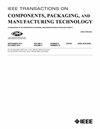A Novel 3-D-Printed Passive Microfluidic Temperature Sensor for Medical Applications
IF 3
3区 工程技术
Q2 ENGINEERING, ELECTRICAL & ELECTRONIC
IEEE Transactions on Components, Packaging and Manufacturing Technology
Pub Date : 2025-03-17
DOI:10.1109/TCPMT.2025.3552029
引用次数: 0
Abstract
The electrical response of a novel passive 3-D-printed temperature sensor could significantly broaden its scope of applications and enhance the integration of microelectro-mechanical system (MEMS) microfluidic-based laboratory-on-a-chip (LOC) technologies. This article introduces an innovative temperature sensor based on the microfluidic technology which is well-suited for medical applications. The sensor’s design and optimization were conducted using multiphysics modeling and finite element method (FEM) simulations, implemented through FreeFEM++ software. Samples were produced using stereolithographic 3-D printing. A metal carrier was constructed to secure the chips during tank heating and the flow visualization with a microscope. X-ray microtomography tests were performed on chips to compare real parts with CAD models. Filling tests were conducted to position the liquid within the microfluidic channel. Furthermore, several types of liquids were tested, and contact angle (CA) measurements were employed to characterize the microfluidic chip’s structural material (DS3000) and various liquids, aiding in discerning the dielectric liquid were applied also. Among the liquids tested, water emerged as the most promising for this type of temperature sensor. Volume expansion calculations for different temperature values were performed, revealing a measured linear thermal expansion exceeding一种新型3d打印无源微流控温度传感器的医疗应用
一种新型无源3d打印温度传感器的电响应可以显著拓宽其应用范围,并增强基于微流体的微机电系统(MEMS)芯片实验室(LOC)技术的集成。本文介绍了一种基于微流控技术的新型温度传感器,该传感器非常适合于医学应用。利用多物理场建模和有限元方法(FEM)仿真,通过FreeFEM++软件实现传感器的设计和优化。样品是用立体平版3d打印生产的。在加热和显微镜观察过程中,构建了金属载体来固定芯片。对芯片进行x射线显微断层扫描测试,将真实零件与CAD模型进行比较。进行填充试验以确定微流体通道内液体的位置。此外,还测试了几种类型的液体,并利用接触角(CA)测量来表征微流控芯片的结构材料(DS3000)和各种液体,帮助识别介电液体。在测试的液体中,水是这种类型的温度传感器最有希望的液体。进行了不同温量值的体积膨胀计算,揭示了在$20~^{\circ}$ C - $55~^{\circ}$ C范围内测量的线性热膨胀超过$40~\mu $ m/°C。该研究为能够利用温度效应测量低流速的微流体装置铺平了道路,从而提供了16个电响应。
本文章由计算机程序翻译,如有差异,请以英文原文为准。
求助全文
约1分钟内获得全文
求助全文
来源期刊

IEEE Transactions on Components, Packaging and Manufacturing Technology
ENGINEERING, MANUFACTURING-ENGINEERING, ELECTRICAL & ELECTRONIC
CiteScore
4.70
自引率
13.60%
发文量
203
审稿时长
3 months
期刊介绍:
IEEE Transactions on Components, Packaging, and Manufacturing Technology publishes research and application articles on modeling, design, building blocks, technical infrastructure, and analysis underpinning electronic, photonic and MEMS packaging, in addition to new developments in passive components, electrical contacts and connectors, thermal management, and device reliability; as well as the manufacture of electronics parts and assemblies, with broad coverage of design, factory modeling, assembly methods, quality, product robustness, and design-for-environment.
 求助内容:
求助内容: 应助结果提醒方式:
应助结果提醒方式:


